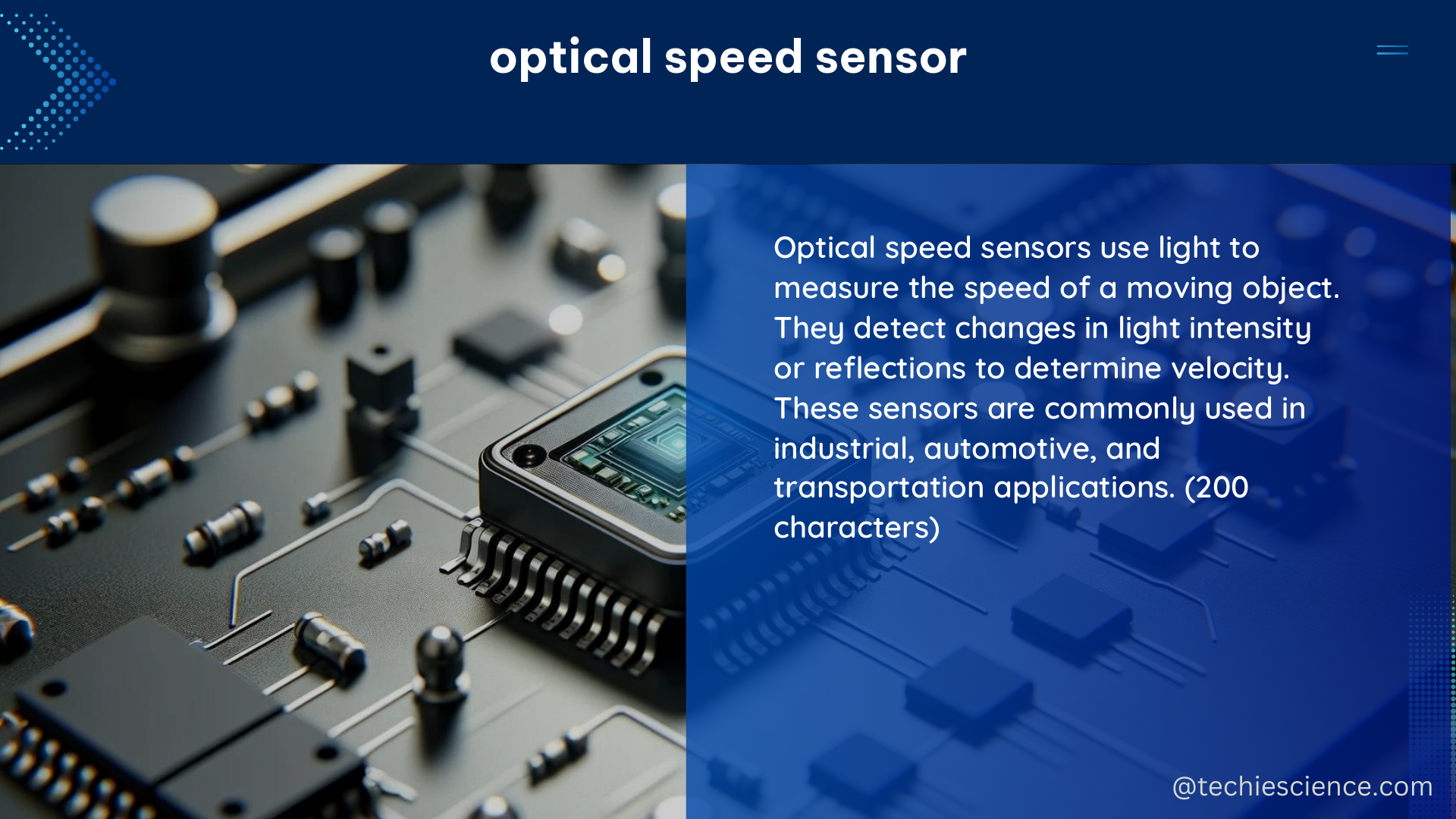The optical speed sensor is a versatile and powerful device that converts optical radiation into an electrical signal, providing precise information about the speed of moving objects. Its principle of operation is based on the fundamental laws of optics, offering several advantages over traditional electrochemical and mechanical methods, such as high speed, measurement accuracy, high sensitivity, and a wide measuring range.
Understanding the Principles of Optical Speed Sensors
Optical speed sensors work by detecting changes in the optical properties of a moving object, such as its reflectivity, refraction, or diffraction. These changes are then converted into electrical signals that can be used to calculate the object’s speed. The key components of an optical speed sensor include:
- Light Source: The sensor uses a light source, such as a laser or LED, to illuminate the moving object.
- Optical Detector: The detector, typically a photodiode or phototransistor, measures the changes in the optical properties of the moving object.
- Signal Processing: The electrical signals from the optical detector are processed and converted into a speed measurement.
The sensitivity of an optical speed sensor is a crucial performance indicator, representing the ratio of the change in the output signal to the change in the input signal. This is usually expressed in volts per unit of optical power or amperes per unit of optical power. The response time, another essential parameter, indicates the time it takes for the sensor to respond to a change in the input signal, typically measured in seconds or milliseconds.
Types of Optical Speed Sensors

Optical sensors can be divided into four main types based on the principle of optical-electrical conversion:
- Photoelectron Emission: These sensors use the photoelectric effect to convert optical radiation into an electrical signal.
- Photoconductivity: These sensors rely on the change in electrical conductivity of a material when exposed to light.
- Photovoltaic: These sensors generate an electrical voltage when exposed to light, based on the photovoltaic effect.
- Pyroelectric: These sensors generate an electrical charge in response to a change in temperature, which can be caused by the absorption of light.
Additionally, sensors that use active light according to the laws of reflection, refraction, diffraction, and the passage of light through a heterogeneous medium are also considered optical sensors.
Technical Specifications and Applications
The technical specifications of an optical speed sensor can vary widely depending on the specific application. For instance, in the context of measuring the speed of a moving object, the sensor’s range may vary from a few centimeters per second to several hundred kilometers per hour. The sensor’s resolution, accuracy, and repeatability also depend on the application and the quality of the sensor itself.
Optical speed sensors have a wide range of applications, including:
- Transportation: Measuring the speed of vehicles, trains, and other modes of transportation.
- Sports and Recreation: Tracking the speed of athletes, balls, and other moving objects in sports.
- Industrial Automation: Monitoring the speed of conveyor belts, rotating machinery, and other industrial processes.
- Research and Development: Studying the dynamics of fast-moving objects in scientific experiments.
Building a DIY Optical Speed Sensor
For DIY enthusiasts, there are several resources available online that provide detailed instructions on building and calibrating optical speed sensors. These resources typically include schematics, parts lists, and step-by-step instructions, as well as tips and tricks for optimizing the sensor’s performance.
However, it’s important to note that building a high-quality optical speed sensor requires a solid understanding of optics, electronics, and sensor design principles. This may not be suitable for beginners or those without the necessary skills and experience.
Some key considerations when building a DIY optical speed sensor include:
- Light Source Selection: Choosing the appropriate light source, such as a laser or LED, based on the specific application and performance requirements.
- Optical Detector Design: Selecting the right optical detector, such as a photodiode or phototransistor, and designing the associated circuitry for signal processing.
- Mechanical Design: Ensuring the sensor’s mechanical components, such as the housing and mounting, are designed to minimize vibrations and environmental interference.
- Calibration and Optimization: Developing a calibration process to ensure the sensor’s accuracy and repeatability, and optimizing its performance for the specific application.
Conclusion
The optical speed sensor is a versatile and powerful tool for measuring the speed of moving objects, providing high accuracy, high sensitivity, and a wide measuring range. However, it also has some limitations and requires careful consideration of various factors, such as sensitivity to environmental conditions, cost, and complexity of implementation.
With the right resources and expertise, it is possible to build a high-quality optical speed sensor tailored to specific applications. By following the principles and guidelines outlined in this comprehensive guide, DIY enthusiasts can explore the fascinating world of optical speed sensing and create their own customized solutions.
References:
– ScienceDirect Topics. (n.d.). Optical Sensor – an overview. Retrieved May 10, 2024, from https://www.sciencedirect.com/topics/materials-science/optical-sensor
– NCBI. (2021, December 30). Information Conversion in Measuring Channels with Optoelectronic … Retrieved May 10, 2024, from https://www.ncbi.nlm.nih.gov/pmc/articles/PMC8749807/
– MDPI. (2020, December 24). Combining Radar and Optical Sensor Data to Measure Player Value … Retrieved May 10, 2024, from https://www.mdpi.com/1424-8220/21/1/64
– InTechOpen. (2008, October 01). Optical Speed Measurement and applications. Retrieved May 10, 2024, from https://cdn.intechopen.com/pdfs/5696/InTech-Optical_speed_measurement_and_applications.pdf
– ResearchGate. (n.d.). Optical Speed Measurement and Applications. Retrieved May 10, 2024, from https://www.researchgate.net/publication/221787281_Optical_Speed_Measurement_and_Applications

The lambdageeks.com Core SME Team is a group of experienced subject matter experts from diverse scientific and technical fields including Physics, Chemistry, Technology,Electronics & Electrical Engineering, Automotive, Mechanical Engineering. Our team collaborates to create high-quality, well-researched articles on a wide range of science and technology topics for the lambdageeks.com website.
All Our Senior SME are having more than 7 Years of experience in the respective fields . They are either Working Industry Professionals or assocaited With different Universities. Refer Our Authors Page to get to know About our Core SMEs.